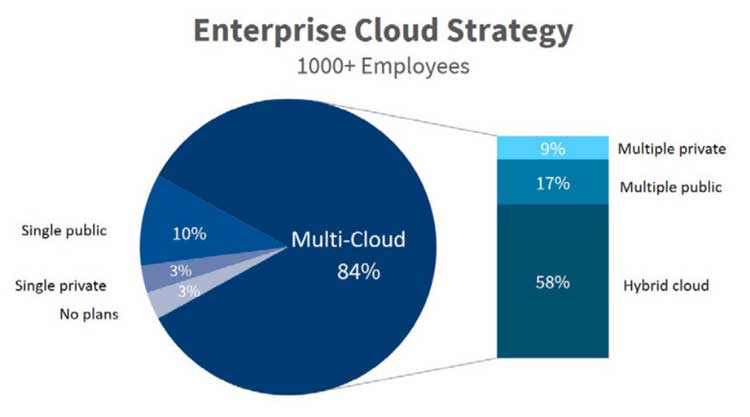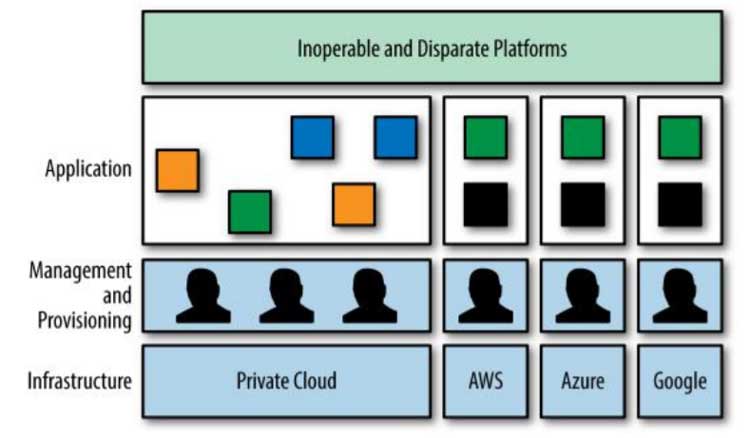Hybrid multicloud is the new normal in IT. The Voice of the Enterprise Digital Pulse report by 451 Research found that 3 in 5 of nearly 1,000 companies surveyed have implemented a hybrid IT environment with integrated on-and off-premises cloud services. For enterprise companies, government organizations, and educational institutes, the proportion increases to nearly three quarters.
That figure is projected to go up to 90 percent by the end of this year, according to a study by Gartner. From the findings of multiple studies and reports such as these, it’s safe to assume that IT is heading towards a distributed and interoperable environment of on-premises infrastructure and hybrid multicloud.
The path, however, is fraught with never-seen-before complexities. If not addressed on time, these challenges can significantly affect the organization’s growth prospects or stall operations. “Organizations that adopt hybrid infrastructure will optimize costs and increase efficiency. However, it increases the complexity of selecting the right toolset to deliver end-to-end services in a multi-sourced environment,” said D. D. Mishra, Research Director at Gartner.
There are common and uncommon challenges affecting hybrid cloud deployment in SMBs as well as the enterprise, including migration, governance, provisioning, security, compliance and cost.
1. Migration
The first step is more often than not the hardest. Moving to a hybrid cloud system from a private or public cloud infrastructure or an in-house data center is a time-consuming and resource-intensive process.
The current applications and workload should be seamlessly portable and operable across an on-premises framework as well as a third party-managed public cloud. Further, the organization may be using different cloud stacks of varying complexity. Migrating to a single or centrally managed hybrid cloud involves integrating different specific cloud brands and providers, and their native or proprietary features and components (such as databases, machine learning, and native monitoring systems).
Many organizations do not have the in-house IT skills required for analysis and deployment and need to call in external consultants or use a managed service provider (MSP). Before starting the migration, IT needs to analyze and make decisions about:
operational requirements and performance characteristics of workloads and compare the economics (price vs. performance) of execution venues
container and microservices coding platforms for testing and iterations of application development
capacity planning and eliminating unused or underutilized services
provisioning of data, storage, compute, network, security, and application stacks
financial metering, reporting, and chargeback by cloud, tenant, user, application, compute and other consumption-based services
2. Governance
Standardization of processes is the primary goal of IT governance in the enterprise. Traditionally, the need for governance arose to provide oversight and direction. Regardless of the existing systems of private or public clouds, the management of a hybrid cloud that incorporates multiple systems will be more complex.
The Rightscale State of the Cloud report found that cloud governance was the top challenge for both enterprises and SMBs in 2019, with 84 percent enterprise respondents listing it as a concern, especially because they have a multicloud strategy in place.

Source: Designing and Building a Hybrid Cloud
Approach the solution from three angles: increased automation, self-service or managed, and a software-defined, unified management plane.
Achieve this through various Cloud Management Platforms (CMP) that enable granular, single-console monitoring and management of data, security, policy and process implementation, and cross-management of public and private clouds. A hybrid cloud platform creates an abstraction layer between the admin user and the platform-native compute, storage, and networking services.
3. Provisioning
Cloud provisioning is the allocation of a cloud provider’s resources and services, including infrastructure as a service (IaaS), software as a service (SaaS), platform as a service (PaaS), and more recently, desktop as a service (DaaS).
Hybrid cloud systems can utilize one of two provisioning methods. The first, dynamic provisioning or cloud bursting, is when the deployment scales up or down to match fluctuating demands and accommodate spikes and dips in usage and billing is on a pay-per-use basis. The second, self-provisioning, is a form of managed self-service where the IT department buys additional resources on the public cloud as and when needed.
It is now possible to automate the provisioning of hybrid cloud architecture by scaling multi-tiered, distributed applications across cloud environments using a plethora of orchestration tools. The consumption component of the unified CMP interface can show the true costs of consumption and avoid a billing or toolchain nightmare.
Additionally, while new applications might not be cloud-native, existing applications are often too complex or expensive to refactor. The immediate solution is implementing a single, end-to-end view for tracking all ops.
4. Security
Security is the elephant in the room when it comes to hybrid cloud complexity. The weakest link is one or more of the public clouds in the infrastructure, where security is API-driven. Therefore, it is set up by developers who may or may not be familiar with the right security practices or implementation required by each client organization.
Further, the public cloud providers’ service level agreement (SLA), which contains the conditions, guarantees, and terms of their service regarding system uptime and data availability, warrants a closer look when it’s part of a hybrid cloud deployment. The SLA needs to be reviewed by both the IT and legal departments for potential issues, as compromised data or lost transactions might lead to a tarnished brand reputation or even lawsuits.
These risks and threats are amplified in a multicloud environment, which is a given these days. Hybrid cloud deployments, therefore, need to address security from three viewpoints: visibility, control, and optimization:

Source: Nutanix
In enterprise environments, critical data is mostly securely housed in a private cloud, whether it’s in physical on-premises or co-located servers or a VPN. The data moves to and from public clouds which have huge computing resources to power resource-intensive applications and workloads that deliver valuable business insights. This data transfer leads to different security challenges:
When data passes between different cloud environments, it is vulnerable to volumetric DDoS and other man-in-the-middle attacks. The hybrid cloud architecture needs to incorporate software encryption and hardware security modules (HSM) to fortify data.
In many industries, the private and public cloud components of a hybrid infrastructure need to be evaluated as separate environments from a compliance perspective, to adhere to various government regulations or industry standards. Data governed by these restrictions are fair game for hackers, and its storage and access methods should be planned from the early stages of deployment.
In workplaces where employees can access customer data from the private cloud or on-premises datacenter, there are potential risks posed by the devices they use, which may be connected to other networks beyond the organization and not fully secured. It is imperative to identify threats at every access point of such devices and enforce tough security protocols to prevent data leakage.
5. Compliance
As hybrid cloud deployments are primarily the domain of large organizations, regulations governing the use and storage of sensitive customer data is a huge concern. In many cases, this calls for additional tools, resources, and training for IT professionals in addition to the tech re-skilling required for the hybrid implementation.
With the hybrid cloud, organizational policies need to scale up too. In addition to data storage and security, these policies will affect availability, capacity, cost, and disaster recovery. However, this itself is a reason companies choose a hybrid model, rather than let their applications run at the mercy of a public cloud provider. They just need to make sure the providers they use have the necessary certifications and policies that comply with the appropriate regulations applicable to their workloads and data.
Finally, the number and roles of people who access the infrastructure, locations, the scope of work, and data access levels all matter while ensuring compliance. Different departments with varying data access levels need to be trained and coached on how their cloud activities correlate to business or organizational outcomes.
6. Costs
All the IT infrastructure management challenges – whether it is cloud computing or on-premises data centers or just servers and user devices – boils down to IT costs.
For companies moving from the public cloud, the ability to easily use additional resources is a pitfall that could lead to wasted spending and ballooning IT budgets. Moving to a hybrid cloud system from a private cloud provides ample opportunities to reduce costs; however, these costs need to be factored in properly in the first place.
A hybrid deployment lets the organization decide whether to use an OPEX or CAPEX billing model and respond to business needs as they see fit. Other considerations include single-tenancy vs. multi-tenancy, vendor and provider selection for different clouds or applications in the environment, forecasting and provisioning, and governance. A hybrid cloud model helps identify anomalies in all of these areas and prevent organizations from being caught off guard with real-time visibility into inadequacies.
Business Outcomes Matter
Businesses move to the cloud for a reason. Whether the whole organization or affected users are clear on the goals and desired outcomes is another matter. The business needs to answer pointed and unambiguous questions on the new paradigm or transformation that the move will enable.
“Demand for strategic cloud service outcomes signals an organizational shift toward digital business outcomes. The expectations of the outcomes associated with cloud investments, therefore, are also higher,” said Sid Nag, VP of Research at Gartner.
A clear understanding of business objectives and how various systems and providers will help meet these objectives is the harbinger of success in hybrid cloud implementations. “Adoption of next-generation solutions are almost always ‘cloud-enhanced’ solutions, meaning they build on the strengths of a cloud platform to deliver digital business capabilities,” Nag added.
Any conversation around how the hybrid infrastructure is evolving in an organization should include new and emerging technology such as AI, machine learning, and edge computing. These technologies will undoubtedly introduce new challenges, but they will also help achieve business and revenue goals faster.
Featured Image: Pikrepo.com.
Dipti Parmar is a marketing consultant and contributing writer to Nutanix. She writes columns on major tech and business publications such as IDG’s CIO.com, CMO.com, Entrepreneur Mag and Inc. Follow her on Twitter @dipTparmar or connect with her on LinkedIn.
© 2020 Nutanix, Inc. All rights reserved. For additional legal information, please go here.



